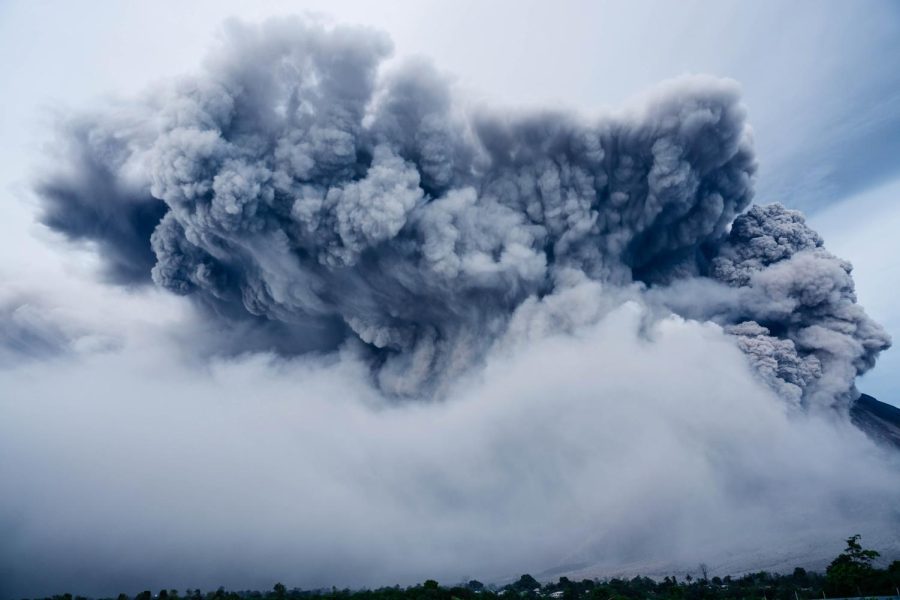January Tonga volcanic eruptions shook the world
On Jan. 14 and 15 two eruptions shook Hunga Tonga residents awake to the grisly sight of ash
Hunga Tonga volcano spews ash and gas high into the air.
Disclaimer: It has come to The Mav’s attention that some of the sources in this article provided incorrect information. Corrections will be given at the bottom of the original article.
On Jan. 14, 2022, the Hunga-Tonga-Hunga-Ha’apai underwater volcano erupted at around 4:20 a.m, exploding hot ash, steam, and gas 12.4 miles into the air, waking up the residents of Tonga to a grim disaster.
More powerful than an atomic bomb, the eruption exploded at 4 to 18 megatons and created not only a meteotsunami that sparked watches throughout the American west coast and other surrounding places, but managed 53 detonators to detect its vibrations from all around the world, many of which can still be felt today, many weeks after the eruption.
Per one of Space.com’s headlines, “[The] eruption was so intense, it caused the atmosphere to ring like a bell.”
The ringing was detected by 53 detectors, one as far as Antarctica, and low frequencies detected (the ringing like a bell) subsequently became the loudest event detected in 20 years.
“Every single station picked it up,” said Le Bras, a geophysicist at the Nuclear-Test-Ban Treaty Organization. “It’s the biggest thing we’ve ever seen.”
The cause of the eruption is from seawater flooding the magma chamber after the chamber shifted and pushed more water inside, causing a “chain reaction” and allowing the perfect environment for an eruption.
The eruption cut power for weeks, isolating survivors on the island from loved ones across the world. Almost all the homes on the main island were destroyed as well as coral reefs around the blast zone. Nomuka Island, 40 miles away, was found to be covered in ash.
The eruption was so intense it altered the weather on the global scale. Jim Garvin, the chief scientist at NASA’s Goddard Space Flight Center said, “This was not your standard Surtseyan eruption because of the large amount of water that had to be involved.”
So far the U.S., New Zealand, Japan, and China have distributed relief to those of Tonga. Five people have been confirmed dead while another 18 have been deemed missing. Power restoration and clean-up efforts are still going on as Tonga residents try to connect to loved ones around the world.
Edited March 16, 2022
Death corrections:
Three people were found deceased. This includes British national, Angela Glover, 50, as well as a 65-year-old female from mango island, and a 49-year old male from Nomuka Island. Nobody is reported missing. One that was reported missing was found deceased.
Damage corrections:
According to ABC, there were “damaged submarine cables creating communication outages and left many Tongan residents homeless”. This created internet outages and limited communication allowed from satellite phones and radio. “All houses [on] Mango Island [were] destroyed”, and “two houses remain on Fonoifua island”. There is “extensive damage on [the] Nomuka Islands”. According to the commenter, coastal damage is mostly what happened (inflicted by Tsunami).
Explosion corrections:
Explosions slowly began on Dec. 20, 2021. According to NPR, “Garvin suspects that the plumbing beneath the surface shifted as the island expanded.” Explosions finally reached the climax on Jan. 15, 2022.
Your donation will support the student journalists of Mead High School. Your contribution will allow us to purchase equipment and cover our annual website hosting costs.

Melia is a senior. She enjoys reading, writing, and listening to music. This is her third year in Journalism. She’s excited to watch her skills grow throughout the school year and see where her writing takes her.






Luisa • Feb 23, 2022 at 3:04 am
Thank you for covering a story of the events that occurred here in Tonga. However, some information is far from the truth. For instance, all houses were not destroyed on our main island (Tongatapu) mainly our coastal areas were affected specifically our village Kanokupolu where most or all houses were sadly destroyed. Also, your numbers of missing and deceased people are incorrect. Only 3 (1 in the main island, and 2 at Ha’apai islands) sadly lost their lives due to the tsunami and no one was reported missing. Nevertheless, we survived and are still here going strong thanks to the Lord’s grace and mercy upon us.
Hope this comment will help you with this story and to provide more factual information. Malo ofa atu.